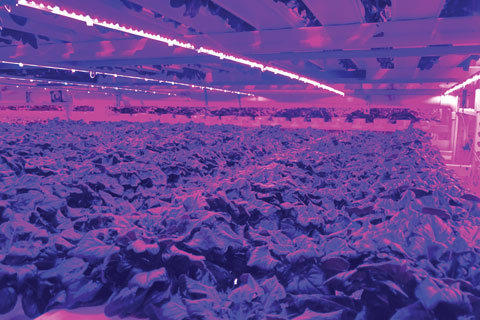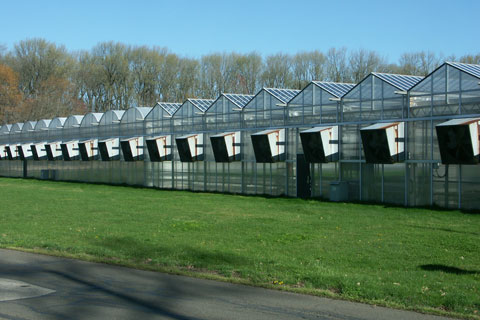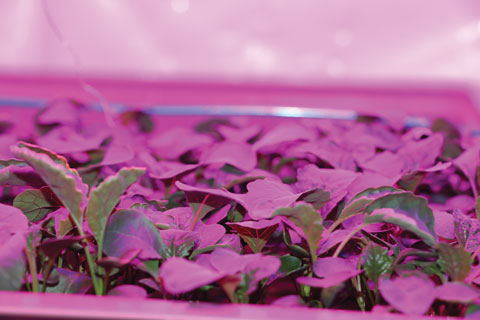2/1/2024
Understanding Your Environment
Ricardo Hernández & Xiaonan Shi

Cultivating crops in controlled environments involves managing various environmental factors such as light, carbon dioxide (CO2), humidity and temperature. These factors are interconnected and impact plant photosynthesis and other metabolic processes. Altering one environmental variable can result in changes in others.
During photosynthesis, plants use CO2 and water, facilitated by light, to produce carbohydrates that support their growth and development. The photosynthesis formula clearly emphasizes the importance of CO2 and light as the primary sources for carbohydrate production.
Pictured: Commercial horticultural LED lights are now reported to provide as much as 3.5 micromoles of light per watt of power every second (3.5 µmol J-1), whereas HPS lights offer approximately 1.9 µmol J-1. This represents an impressive 84% greater efficiency for LEDs.
Humidity in the growing environment plays a key role in the transport and translocation of water and solutes within the plant. Temperature is also crucial for plant growth and development, as all metabolic processes occur within an optimal temperature range.
High tech controlled environment encompasses two main system categories: greenhouse and vertical farming. These systems exhibit varying degrees of susceptibility to external environmental factors and differ in their capacity for environmental control, resulting in distinct control approaches and corresponding economic feasibility.
In vertical farming, plants are cultivated in a fully enclosed environment, where all environmental factors are maintained at specific levels with minimal influence from the outside environment. Conversely, greenhouse production occurs in an environment more susceptible to the impact of the outdoor surroundings. The extent to which the external environment affects the greenhouse is determined by the structure and materials used. Certain control practices can mitigate the impact of external factors to a specific degree within the greenhouse environment.
Factor 1: Light
Light plays a crucial role in the growth and development of plants. In vertical farming, the sole light source is electrical lighting, which entails high energy consumption and initial infrastructure investment. On the other hand, greenhouses are commonly equipped with supplemental lighting, used especially during overcast days or in winter.
Gas discharge lamps, such as high-pressure sodium (HPS), are commonly employed in commercial settings for supplemental lighting. Nevertheless, light-emitting diodes (LEDs) have gradually found their way into controlled environment agriculture, spanning both greenhouse and vertical farming. The primary advantage of LEDs over HPS lies in their energy efficiency. Commercial horticultural LED lights are now reported to provide as much as 3.5 micromoles of light per watt of power every second (3.5 µmol J-1), whereas HPS lights offer approximately 1.9 µmol J-1. This represents an impressive 84% greater efficiency for LEDs.
Factor 2: Carbon Dioxide
Plants utilize CO2 to produce carbohydrates directly linked to yield. The current ambient CO2 levels hover around 410 µmol∙mol-1 (ppm). While this concentration is generally acceptable for plant production in controlled environment systems like vertical farms and greenhouses, it can dip below 200 µmol∙mol-1 in greenhouses with a fully developed canopy under intense solar radiation. This decline in CO2 concentration poses a substantial limitation to photosynthesis, especially under high light intensity.
 In vertical farming, where light intensity is typically lower due to completely electrical lighting, there’s less CO2 fluctuation. However, CO2 enrichment becomes necessary if the vertical farm facility has a low room air exchange rate.
In vertical farming, where light intensity is typically lower due to completely electrical lighting, there’s less CO2 fluctuation. However, CO2 enrichment becomes necessary if the vertical farm facility has a low room air exchange rate.
Pictured: Ventilation, accomplished through fans or opening vents, is the most cost-effective and energy-efficient approach, particularly in greenhouses.
CO2 enrichment is often viewed as a strategy to uphold or enhance yield in both greenhouses and vertical farming. Currently, greenhouses primarily cultivate fruit and ornamental crops, while vertical farming focuses on leafy green production. The variation in crop species between the two systems prompts distinct CO2 enrichment strategies. Different plant species, including cultivars, respond differently to elevated CO2 levels. Crops with a higher Harvest Index, such as lettuce, reap more significant benefits from CO2 enrichment, as the direct increase in photosynthesis enhances the harvestable portion of the plant, constituting nearly the entire plant.
Elevating environmental CO2 levels doesn't automatically ensure sufficient CO2 access for plants. Beyond the importance of the CO2 concentration in the air, the rate at which CO2 diffuses to plants is crucial for effective CO2 uptake during photosynthesis. CO2 diffusion is contingent on the gradient of CO2 concentration from the air to the plant cells, encountering various resistances in the process, including leaf boundary layer resistance and stomatal resistance. These resistances are frequently influenced by additional factors such as wind velocity, the water status of plants (influenced by humidity and irrigation) and the quality of light (which impacts stomatal behavior).
Increasing wind velocity in the environment decreases leaf boundary layer resistance. It’s often recommended to maintain a wind velocity of 0.3 m∙s-1 at the leaf surface to minimize the impact of leaf boundary layer resistance and optimize CO2 diffusion from the air to plant cells. Greenhouses are equipped with fans that can uphold a specified wind velocity. However, in vertical farming, there’s a need for heightened attention to ensure adequate wind velocity for effective CO2 diffusion.
Stomatal resistance occurs when plant stomata are either closed or not fully opened, hindering gas exchange. The primary factors influencing stomatal resistance include plant water status, light quality (specifically blue light) and the concentration of CO2 in the air. Plant water status is linked to irrigation and humidity, which will be further discussed below. Therefore, to enhance photosynthesis through CO2, it’s crucial to consider the CO2 level in the air alongside other environmental conditions affecting the rate of CO2 diffusion in plants.
Factor 3: Humidity
Humidity is a broad term used to describe the quantity of water vapor present in the air. Relative humidity, expressed as a percentage, is often misconstrued with humidity. Relative humidity gauges the actual volume of water vapor in comparison to the total capacity of water vapor that the air can hold and this is relative to the air temperature. Warmer air has the capacity to hold more water vapor than colder air. Consequently, the same amount of water vapor is represented as lower relative humidity when the air temperature is high compared to when it’s low.
Humidity plays a significant role in plant processes such as water uptake, nutrient transport and photosynthesis. Effectively managing humidity in controlled agricultural environments is essential for sustaining robust plant growth and effective pest management. Numerous factors influence the concentration of water vapor in the air, including the transpiration rate of plants, infiltration and ventilation, and the use of active systems for humidification or dehumidification.
 Plants in their growth process release water vapor through stomata in a phenomenon known as transpiration. It’s imperative to eliminate all water transpired by plants from the air to maintain optimal humidity levels. Different crops exhibit varying transpiration rates due to diverse environmental factors. Generally, the transpiration rate increases proportionally with the air vapor pressure deficit (VPD), light intensity, temperature and airspeed. VPD signifies the variance between the actual and maximum water vapor capacity in the air. As VPD rises, plants transpire more rapidly. Consequently, when any of these influencing factors increases, it becomes essential to address excessive water vapor by employing dehumidification methods.
Plants in their growth process release water vapor through stomata in a phenomenon known as transpiration. It’s imperative to eliminate all water transpired by plants from the air to maintain optimal humidity levels. Different crops exhibit varying transpiration rates due to diverse environmental factors. Generally, the transpiration rate increases proportionally with the air vapor pressure deficit (VPD), light intensity, temperature and airspeed. VPD signifies the variance between the actual and maximum water vapor capacity in the air. As VPD rises, plants transpire more rapidly. Consequently, when any of these influencing factors increases, it becomes essential to address excessive water vapor by employing dehumidification methods.
Pictured: It’s often recommended to maintain a wind velocity of 0.3 m∙s-1 at the leaf surface to minimize the impact of leaf boundary layer resistance and optimize CO2 diffusion from the air to plant cells.
Plants cultivated in greenhouses are more exposed to external environmental fluctuations, which can influence their transpiration rates. For instance, on sunny days with high solar radiation, there’s a need for dehumidification, often achieved through ventilation, to maintain the desired humidity within the greenhouse.
Dehumidification methods include ventilation, air conditioning and desiccant systems. Ventilation, accomplished through fans or opening vents, is the most cost-effective and energy-efficient approach, particularly in greenhouses. It proves effective in reducing humidity when the outside air is dry and cool. During winter, when the external air is cold, the air brought in through ventilation requires heating before being exchanged within the greenhouse.
Heating in greenhouses can be achieved through steam, hot water, hot air or infrared methods. In vertical farming, air conditioning is the primary means of regulating air temperature before it’s circulated within the facility (a topic we’ll delve into further below). Another dehumidification method involves solid or liquid desiccant systems that absorb moisture from room air blown across them. While applicable in both systems, this approach isn’t commonly adopted.
Factor 4: Temperature
There’s a notable distinction in temperature regulation between greenhouses and vertical farming. Greenhouses employ two sets of temperature regulation systems: heating and cooling. In contrast, vertical farming typically relies on an HVAC system to maintain the desired temperature. As previously mentioned, there are generally four methods of heating in greenhouses, and the placement of the heating system is crucial for efficient and effective heat delivery.
The cooling process in greenhouses is effectively executed through a combination of cooling pads and fan systems under dry external conditions. However, when the outdoor humidity is high, the insufficient difference in humidity between the exterior and the cooling pad results in minimal temperature drop. A comprehensive assessment of the greenhouse structure offers valuable insights into heat loss, aiding decision-making regarding temperature regulation.
For vertical farming, proper sizing of the HVAC system is crucial as it plays a pivotal role in controlling temperature and regulating humidity. The process of plant transpiration—releasing water vapor into the air—increases humidity and contributes to the energy influx, specifically latent heat, in vertical farming. Due to the enclosed environment of vertical farming, the energy input from transpiration (latent heat) can at times surpass the energy input from equipment such as lights.
Marrying the factors
In the realm of controlled environment agriculture, achieving optimal crop growth demands a careful equilibrium of various environmental factors, including light, carbon dioxide (CO2), humidity and temperature. These interconnected elements wield significant influence over vital plant processes such as photosynthesis and metabolic functions. The distinction between greenhouse and vertical farming systems lies in their susceptibility to external influences and their ability to control the environment. Light, a fundamental driver of plant development, is harnessed differently in each system, with vertical farming relying exclusively on electrical lighting.
CO2 enrichment strategies vary, depending on crop species and system type, highlighting the importance of considering not only ambient CO2 concentration, but also diffusion rates. Managing humidity is critical for fostering healthy plant growth, necessitating the implementation of effective dehumidification methods. Temperature regulation diverges between greenhouses and vertical farming, each employing distinct heating and cooling systems. This delicate balance ensures optimal conditions for plant growth and underscores the intricate relationship between environmental factors in controlled agriculture.
Click here to learn more about the Controlled Environment Coalition of researchers at North Carolina State University.
Dr. Ricardo Hernández is an Associate Professor at North Carolina State University, focused on controlled environment research, specializing in optimizing environments to maximize plant responses. As the director of the CEA-Coalition at NCSU, he heads a multidisciplinary research group. Dr. Xiaonan Shi is currently a postdoc scholar at North Carolina State University. Dr. Shi has a research background in controlled environment improvement on plant propagation (including micropropagation) and plant biotechnology, aiming to unlock CEA potentials of innovative and cost-effective solutions to sustainable agriculture development.